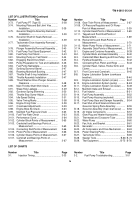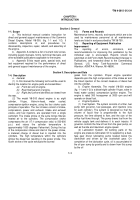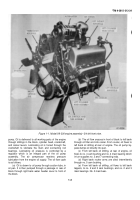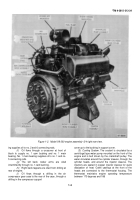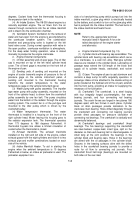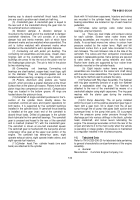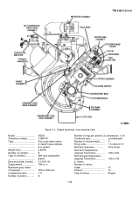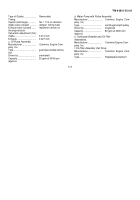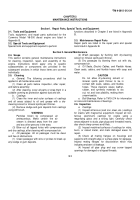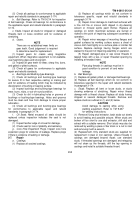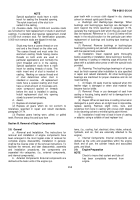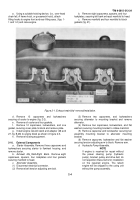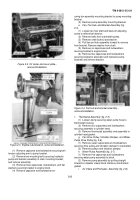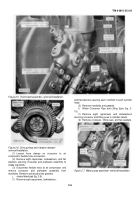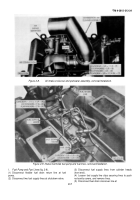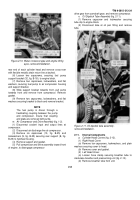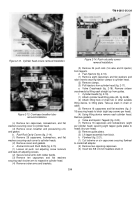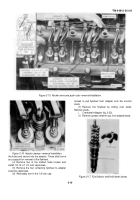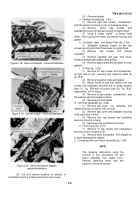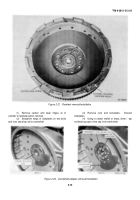TM-9-2815-213-34 - Page 18 of 192
*TM 9-2815-213-34
NOTE
Special application studs have a nylok
insert for sealing the threaded opening.
The nylok insert end of the stud is in-
serted in the casting.
(3)
Oversize studs.
Only 0.003-inch oversize studs
are furnished for field replacement of studs in aluminum
castings. If a standard stud requires replacement, install
a 0.003-inch oversize stud. For identification purposes,
0.003-inch oversize studs are dipped in red dye.
NOTE
Studs may have a coarse thread on one
end and a fine thread on the other end.
The coarse thread end must enter the
aluminum casting. Studs having coarse
threads on both ends are used in
particular applications and normally the
short threaded end is in the casting.
Special application studs have a nylok
insert for sealing threads of studs. The
nylok insert end of stud is inserted in
casting. Marking on coarse thread end
of
stud determines when
stud
is
standard or oversize.
All replacement
studs have a special coating and must
have a small amount of mica-base anti-
seize compound applied on threads
before the stud is installed in casting.
Install replacement stud into opening
slowly to prevent overheating.
d.
Gears.
(1
) Replace all cracked gears.
(2
) Replace all gears which do not conform to
tolerances specified in repair and rebuilt standards,
paragraph 3-174.
(3
) Replace gears having worn, pitted, or galled
teeth. Remove sharp fins and burs from
gear teeth with a crocus cloth dipped in dry. cleaning
solvent or mineral spirits paint thinner.
e.
Bushings and Bushing-type Bearings.
When
bushings and bushing-type bearings are damaged or
worn beyond the limits specified in paragraph 3-174,
generally the mating parts with which they are used must
also be replaced. Reference to (1) and (2) below will be
made in the rebuild section for the particular part when
replacement of bushings and bushing-type bearings is
required.
(1)
Removal.
Remove bushings or bushing-type
bearings by pressing out part with suitable arbor press or
with the special tools provided.
(2)
Installation.
Clean repaired parts thoroughly
before assembly or installation. Aline bushing or bushing-
type bearing in casting or retaining cage and press into
place with a suitable arbor press or with the special tools
provided.
(3)
Reaming.
The bushing-type bearings in oil pump
must be finish reamed after installation to size specified
in repair and rebuild standards. All other bushing-type
bearings are machined for proper clearance and do not
need reaming.
f.
Oil Seals.
Oil seals must be replaced when thin
feather edge is damaged or when seal material has
become hard or brittle.
(1)
Removal.
Press or pry damaged oil seal from
casting or housing, being careful not to damage bore in
casting or housing.
(2)
Repair.
When oil seal bore in casting is burred or
damaged to a point where an oil-tight seal is impossible,
replace
casting.
Remove slight nicks, burs, and
scratches from bore in casting with crocus cloth dipped
in dry-cleaning solvent or mineral spirits paint thinner.
(3)
Installation.
Install new oil seal in bore of casting
or adapter, using a suitable oil seal replacer tool.
Section III. Removal of Engine Components
2-8.
General
a.
Removal and Installation.
The instructions for
removal and installation of engine components have
been arranged in the most logical order of removal for
complete engine disassembly. Installation in general,
shall be the reverse order of the removal instructions. To
facilitate the removal, and later disassembly, assembly
and
installation procedures, the components are
separated into categories, (i.e., external components,
and internal components).
b.
External Components.
External components are
defined as the basic units of the engine sys-
tems, (i.e., cooling, fuel, electrical, drive, intake, exhaust,
hydraulic, and air, that are externally attached to the
engine).
c.
Internal Components.
Internal components are
defined as the units and assemblies within the engine
block and oil pan, the cylinder heads and associated
parts, and block.
2-9.
Engine Preparation
NOTE
Check to insure that coolant and lube oil
has been completely removed from
engine.
2-3
Back to Top

